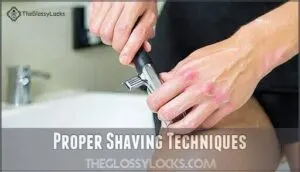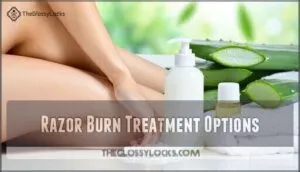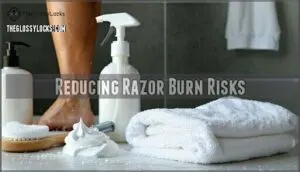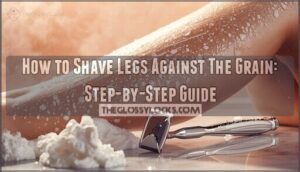This site is supported by our readers. We may earn a commission, at no cost to you, if you purchase through links.
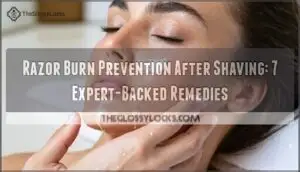 You’ll want to focus on razor burn prevention after shaving by preparing your skin properly before you start.
You’ll want to focus on razor burn prevention after shaving by preparing your skin properly before you start.
Use a sharp, clean razor and shave with the grain, not against it. Apply a quality shaving cream or gel to create a protective barrier between your skin and blade.
Take your time – rushing leads to nicks and irritation.
After shaving, rinse with cool water to close pores and apply a gentle, alcohol-free moisturizer.
Skip the aftershave if you have sensitive skin, as it can make irritation worse. The key is being gentle with your skin throughout the entire process, treating it like the delicate surface it is, and considering sensitive skin and the importance of a protective barrier.
Table Of Contents
- Key Takeaways
- What Causes Razor Burn
- Razor Burn Prevention Tips
- Top 7 Razor Burn Remedies
- Razor Burn Treatment Options
- Preventing Razor Burn Down There
- Reducing Razor Burn Risks
- Frequently Asked Questions (FAQs)
- What do you put on after shaving to prevent razor burn?
- Does moisturizing after shaving prevent razor burn?
- What helps prevent razor burn down there?
- How long does razor burn typically last?
- Can razor burn lead to permanent scarring?
- Is razor burn more common in men?
- Whats the difference between razor burn and bumps?
- Should I see a doctor for razor burn?
- Conclusion
Key Takeaways
- Prep your skin properly – Use warm water and quality shaving cream to soften hair and create a protective barrier before you start shaving
- Follow the grain direction – Always shave with your hair growth, not against it, to prevent follicle damage and reduce irritation
- Use sharp, clean blades – Replace razor blades every 5-7 shaves and rinse frequently during use to avoid tugging and skin trauma
- Apply post-shave care immediately – Rinse with cool water to close pores, then use an alcohol-free moisturizer or aloe vera gel to soothe and protect your skin
What Causes Razor Burn
You’re dealing with razor burn because your shaving routine is causing friction and irritation to your skin.
The main culprits include dry shaving without proper lubrication, using dull razor blades that tug at hair follicles, or shaving against the direction of hair growth, which can lead to irritation.
Dry Shaving Risks
Dry shaving creates a perfect storm for razor burn prevention nightmares.
Without water or shaving cream, your razor drags across unprotected skin, causing severe irritation severity and boosting infection potential.
This harsh friction damages your skin’s protective barrier, increasing skin sensitivity and creating long-term damage risks.
Always prep with moisture before shaving—your skin deserves better than this sandpaper treatment.
Dull Razor Blades
Blade sharpness directly impacts razor burn prevention.
When razor blades lose their edge, they require more pressure and multiple passes to cut hair effectively. This increased friction damages your skin and hair follicles, creating the perfect storm for irritation.
Here’s how dull blades wreak havoc on your skin:
- Tugging and pulling hair instead of cleanly cutting through it
- Requiring excessive pressure that scrapes and damages skin layers
- Creating microscopic nicks that become inflamed and irritated
- Forcing multiple passes over the same area, multiplying skin trauma
- Leaving uneven stubble that increases future shaving difficulty
Replace razor blades every 5-7 shaves for ideal blade lifespan. To maintain blade quality, consider preventing razor rust. Regular razor maintenance and monitoring shaving frequency helps maintain razor sharpness and reduces skin irritation risks.
Shaving Against Hair Growth
When you shave against hair growth, you’re fighting your follicles instead of working with them. This aggressive approach causes significant follicle damage and irritation severity that leads to razor burn and ingrown hairs.
Don’t fight your follicles—work with them to avoid painful razor burn.
Shaving against hair growth pulls strands from follicles, creating microscopic wounds. For ingrown hair prevention and razor burn treatment, always follow your hair’s natural direction. This simple change dramatically reduces preventing razor bumps and provides shaving irritation relief.
| Hair Growth Direction | Irritation Level | Prevention Method |
|---|---|---|
| With the grain | Low | Natural shaving direction |
| Across the grain | Moderate | Gentle strokes only |
| Against the grain | High | Avoid completely |
| Mixed directions | Variable | Map hair texture first |
| Problem areas | Severe | Consider shaving alternatives |
Razor Burn Prevention Tips
You can prevent razor burn by following proper shaving techniques and preparing your skin correctly before each shave.
These simple steps will help you avoid the painful redness and irritation that comes after using a razor, by following complete concepts that are essential for a smooth shaving experience.
Proper Shaving Techniques
Master proper shaving techniques to prevent razor burn and achieve smooth results.
Maintain your blade angle at 30 degrees against skin for ideal cutting without excessive pressure.
Practice gentle skin stretching to create a flat surface for your razor.
Reduce shaving frequency to allow skin recovery between sessions.
Focus on razor maintenance by rinsing blades frequently and replacing them regularly.
To further soothe skin, consider using aloe-rich aftershaves.
These shaving techniques minimize shaving irritation relief needs while preventing razor bumps naturally.
Skin Preparation Methods
Preparation transforms your skin from vulnerable to protected.
Start with warm water to soften hair follicles and open pores.
Gentle exfoliation before shaving removes dead skin cells that can clog your razor.
Apply pre-shave oils to create a protective barrier.
Consider high quality options for enhanced skin protection.
Proper skin cleansing removes dirt and bacteria.
This hydration importance can’t be overstated—moisturized skin resists irritation better than dry skin.
Top 7 Razor Burn Remedies
You can treat razor burn effectively with the right products and techniques. These seven dermatologist-recommended remedies will help soothe irritated skin and speed up healing after shaving mishaps.
1. Cortizone 10 Anti-Itch Cream Aloe
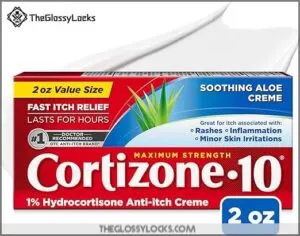
When razor burn strikes, you need fast-acting relief that won’t irritate your already sensitive skin.
Cortizone 10 Maximum Strength Soothing Aloe Anti-Itch Cream delivers exactly that with its 1% hydrocortisone formula.
This doctor-recommended treatment starts working within 10 minutes, providing hours of itch relief.
The added aloe vera soothes inflammation while the fragrance-free formula won’t trigger additional irritation.
Apply sparingly to affected areas up to four times daily for maximum seven days.
Best For: Those seeking fast, non-irritating relief from itchy, inflamed skin caused by razor burn, eczema, or allergies.
- Starts relieving itch within 10 minutes and lasts for hours
- Gentle, fragrance-free formula with soothing aloe vera
- Doctor-recommended and available without a prescription
- May cause a slight burning sensation or skin bleaching with overuse
- Not as moisturizing as some users prefer
- Requires reapplication every 6 hours for lasting relief
2. La Roche Posay Cicaplast Balm
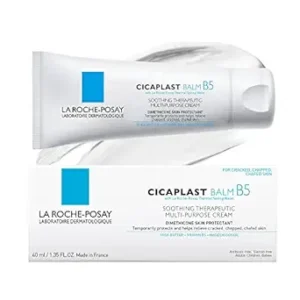
La Roche-Posay’s Cicaplast Balm works like a protective shield for your irritated skin.
This dermatologist-recommended formula contains 5% panthenol and madecassoside, which actively reduce redness and accelerate healing.
You’ll notice the thick texture creates a barrier that locks in moisture while fighting inflammation.
Clinical studies show 84% improvement in skin healing within two weeks.
Apply generously to clean, dry skin after shaving—it’s safe for face and body use.
The fragrance-free formula won’t sting sensitive areas.
Best For: Those with cracked, chapped, or irritated skin—including sensitive, post-shave, baby, and compromised skin barriers—seeking fast, gentle repair.
- Soothes and heals irritated or damaged skin quickly with panthenol and madecassoside.
- Non-greasy, fragrance-free, and suitable for all ages (including infants).
- Clinically proven to reduce redness and speed up recovery within two weeks.
- Thick texture may leave a temporary white cast, especially on darker skin tones.
- Best used at night due to slight sheen and occlusive barrier.
- Can feel heavy or occlusive for those preferring lightweight creams.
3. Tend Skin Ingrown Hair Solution
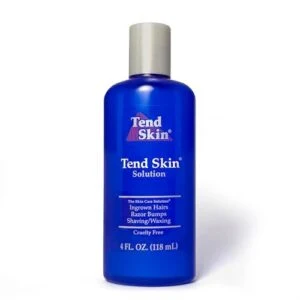
Tend Skin’s alcohol-based formula works like a skin reset button, eliminating razor burn within twelve hours of application.
This powerful solution contains acetylsalicylic acid that exfoliates dead skin cells while reducing inflammation around irritated follicles.
Apply it immediately after shaving using a cotton pad, targeting problem areas like your bikini line or neck.
Expect temporary stinging that quickly fades, and note that at $18.99 for a four-ounce bottle, it delivers professional-grade results that last over a year with consistent use.
Best For: Anyone dealing with stubborn ingrown hairs, razor bumps, or irritation after shaving or waxing.
- Strong alcohol scent and temporary stinging on application.
- Pricier than typical drugstore products.
- Not suitable for anyone allergic to aspirin.
- Eliminates razor burn and ingrown hairs quickly, often within 12 hours.
- Lightweight, non-greasy formula absorbs fast and soothes skin.
- Long-lasting value—a single bottle lasts over a year with regular use.
4. eos Sensitive Skin Shaving Cream
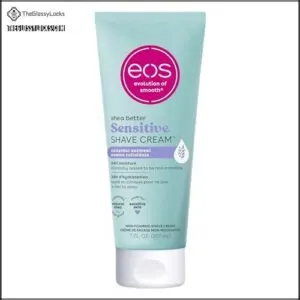
Frequently overlooked by shavers, this gynecologist-tested cream transforms your routine with colloidal oatmeal and shea butter.
You’ll get 24-hour hydration that prevents nicks and razor burn on sensitive areas like your bikini line.
The fragrance-free, hypoallergenic formula works wet or dry, creating a protective barrier during shaving.
Clinical testing shows 92% of users experience reduced irritation, with the cream providing extended moisture when left on after shaving.
Apply a thin layer before shaving, then rinse or leave on for extended moisture.
Best For: People with sensitive skin looking for a hydrating, fragrance-free shave cream safe for intimate areas.
- Clinically shown to reduce irritation and razor burn, especially on sensitive skin.
- Provides 24-hour hydration with shea butter, shea oil, and colloidal oatmeal.
- Hypoallergenic, vegan, cruelty-free, and free from parabens, phthalates, and fragrances.
- Requires a razor—cannot be used as a wipe-off hair remover.
- Thicker texture means product may be used up faster than foaming creams.
- Not recommended for facial use.
5. iS CLINICAL Hydra Cool Face Serum
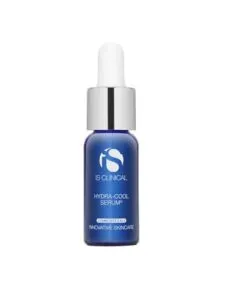
Beyond the typical post-shave lotions, iS CLINICAL Hydra Cool Face Serum delivers intensive hydration through sodium hyaluronate, which holds up to 1,000 times its weight in water.
The menthol creates an immediate cooling sensation that calms razor burn irritation.
This lightweight serum absorbs quickly without sticky residue, making it perfect for sensitive skin after shaving.
Its antioxidant-rich formula with Centella Asiatica supports skin healing while vitamin B5 enhances repair, transforming your post-shave routine into professional-grade skincare.
Best For: Men and women seeking deep hydration and calming relief for sensitive, irritated, or freshly shaved skin.
- Intensively hydrates and calms skin with fast-absorbing, non-sticky formula.
- Reduces redness and irritation post-shave with soothing menthol and botanicals.
- Dermatologist recommended and suitable for all skin types, including sensitive and acne-prone.
- Menthol may irritate especially sensitive skin.
- Price is higher than many alternatives, with reports of counterfeits.
- Dispenser type and shipping issues have caused some customer dissatisfaction.
6. Aquaphor Healing Ointment for Dry Skin
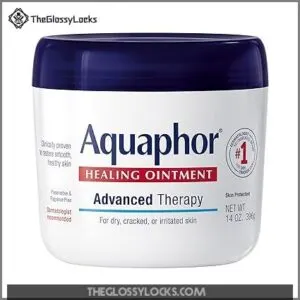
This multipurpose ointment works like a protective shield for irritated skin after shaving.
You’ll find Aquaphor’s 41% petrolatum formula creates a semi-occlusive barrier that locks in moisture while allowing your skin to breathe naturally.
It’s fragrance-free and preservative-free, making it perfect for sensitive areas prone to razor burn.
Apply a thin layer to clean, damp skin immediately after shaving to accelerate healing and prevent further irritation from developing, utilizing its semi-occlusive barrier to lock in moisture.
Best For: Anyone with very dry, sensitive, or irritated skin, especially those seeking relief from post-shave redness, chapped lips, or minor wounds.
- Clinically proven to heal and protect extremely dry or compromised skin
- Fragrance-free, preservative-free, and non-comedogenic, making it suitable for sensitive skin
- Versatile use for hands, feet, cuticles, minor wounds, and post-shaving care
- Thick texture may feel heavy or greasy for some users, especially during daytime use
- Unscented formula may not appeal to those who prefer fragranced skincare
- Not suitable for individuals with allergies to specific ingredients like lanolin alcohol
7. CeraVe Moisturizing Cream for Dry Skin
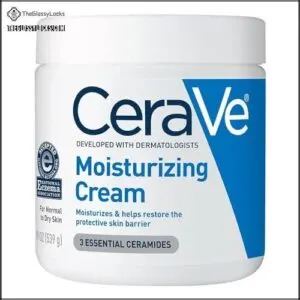
Your skin craves deep hydration after shaving, and CeraVe Moisturizing Cream delivers exactly that.
This dermatologist-developed formula combines three essential ceramides with hyaluronic acid to restore your skin’s protective barrier while locking in moisture for 24 hours.
The MVE technology releases moisturizing ingredients gradually, preventing that tight, uncomfortable feeling post-shave.
It’s fragrance-free and non-comedogenic, making it perfect for sensitive skin that’s prone to razor burn irritation, and provides long-lasting hydration.
Best For: People with dry, sensitive, or eczema-prone skin seeking long-lasting hydration and barrier repair, especially after shaving.
- Deeply hydrates and restores the skin barrier for 24 hours.
- Fragrance-free, hypoallergenic, and safe for sensitive or post-shave skin.
- Dermatologist-developed and accepted by the National Eczema Association.
- May feel too rich or take time to fully absorb on oily skin.
- Tub packaging isn’t as hygienic as a pump.
- Not the lightest formula for those who prefer a thinner moisturizer.
Razor Burn Treatment Options
When razor burn strikes after shaving, you need fast relief to calm irritated skin and prevent further damage.
These treatment options work quickly to reduce inflammation and restore your skin’s natural barrier, providing fast relief.
Cool Compress Application
When razor burn strikes, reach for a cold compress to calm angry skin.
Apply a clean, damp cloth soaked in cool water for 15-20 minutes. This simple compress duration helps constrict blood vessels, reducing skin redness and inflammation while easing itching.
Repeat application frequency as needed throughout the day for maximum relief. Cool compresses offer immediate relief options for immediate soothing.
Aloe Vera Gel Benefits
Aloe vera gel works wonders for razor burn because it’s naturally loaded with anti-inflammatory properties that calm angry skin fast.
This plant-based remedy delivers serious moisturizing effects while promoting healing at the cellular level.
You’ll feel immediate skin soothing when you apply pure aloe vera gel to irritated areas.
Discover aloe vera products for various skin needs.
The cooling sensation provides instant relief from burning and stinging sensations that follow harsh shaving sessions, offering instant relief and promoting healing.
Natural Oils for Skin Soothing
Nourishing your skin with natural oils offers powerful skin soothing benefits after shaving.
Jojoba oil mimics your skin’s natural sebum, providing deep hydration without clogging pores.
Tea tree oil’s anti-inflammatory properties reduce redness and prevent infection in micro-cuts.
Grapeseed oil contains antioxidants that combat inflammation and protect sensitive skin.
Jojoba oil also offers anti-inflammatory properties to calm and soothe irritated skin.
For DIY blends, mix 2-3 drops of jojoba with lavender oil for enhanced healing effects.
Preventing Razor Burn Down There
Shaving sensitive areas requires extra care to prevent painful razor burn and irritation. You’ll need to use gentler techniques and make specific clothing choices to protect freshly shaved skin.
Gentle Shaving Methods
When shaving intimate areas, your blade angle matters more than you think.
Hold your razor at a 30-degree angle and use gentle pressure – let the blade do the work.
Keep stroke length short and controlled, moving with hair growth direction.
Choose a single-blade or safety razor for better pressure control.
These shaving techniques guarantee a smooth shave while minimizing irritation in sensitive areas.
Prior to shaving, consider using a shave cream to create a barrier to reduce irritation and ensure a more comfortable shave.
Avoiding Tight Clothing
Tight clothing after shaving creates friction that worsens razor burn and prolongs healing.
Choose loose, Breathable Materials like cotton to allow Skin Breathing and reduce irritation.
Post-Shave Fabrics should prioritize comfort over style – your skin needs space to recover.
Friction Reduction through Clothing Alternatives prevents further inflammation.
Consider Skin Sensitivity when selecting garments, avoiding skin tight clothes that trap heat and moisture against freshly shaved areas.
Using shaving cream provides essential skin lubrication during shaving to achieve smooth skin.
Reducing Razor Burn Risks
You can substantially reduce your razor burn risk by focusing on three key prevention strategies. Proper preparation and technique make all the difference between smooth skin and painful irritation.
Exfoliating Before Shaving
Gentle pre-shave exfoliation removes dead skin cells that create friction and trap hairs beneath the surface.
Use a mild scrub or chemical exfoliant 2-3 times weekly to prevent ingrown hairs and improve razor glide.
This simple skin preparation step reduces razor burn by clearing pore blockages, allowing smoother blade contact for cleaner cuts.
Shaving in Hair Growth Direction
Following hair growth patterns during your shaving routine dramatically reduces razor burn risk.
When you shave against the grain, you’re basically pulling hair away from follicles, creating irritation and inflammation that leads to that familiar burning sensation.
Here’s your directional shaving game plan:
- Map your hair growth patterns – Run your hand over dry skin to feel which direction hair naturally lies
- Start with gentle, downward strokes – Most facial hair grows downward, so begin there for the best shaving angle
- Focus on sensitive skin concerns – Areas like your neck may have multiple growth directions requiring extra attention
This ingrown hair prevention technique works because you’re working with your body’s natural design rather than fighting against it.
The directional shaving benefits include smoother results with less skin trauma.
Using Sharp Razor Blades
Your razor’s sharpness directly impacts your skin’s wellbeing.
Dull blades require more pressure and multiple passes, increasing friction that leads to razor burn.
Sharp razor blades glide smoothly, cutting hair cleanly without tugging or scraping skin.
Consider buying quality shaving products for a smoother experience.
Replace disposable razors after 5-7 uses or when you feel resistance.
For multi-blade razors, proper razor maintenance includes rinsing after each stroke and storing in dry areas to prevent rust.
Frequently Asked Questions (FAQs)
What do you put on after shaving to prevent razor burn?
Apply a fragrance-free moisturizer, cooling aloe vera gel, or hydrocortisone cream immediately after shaving. These products soothe irritation, restore your skin’s protective barrier, and prevent the angry redness that follows.
Does moisturizing after shaving prevent razor burn?
Yes, moisturizing after shaving helps prevent razor burn by restoring your skin’s protective barrier and reducing inflammation.
You’ll want fragrance-free moisturizers with ingredients like ceramides or hyaluronic acid for best results.
What helps prevent razor burn down there?
Use sharp razors, shave with hair growth direction, prep skin with warm water and cream, moisturize afterward, and wear loose clothing to prevent irritation.
How long does razor burn typically last?
Most razor burn clears up within 24 to 48 hours on its own.
You’ll notice the redness and irritation start fading after the first day, with complete healing typically occurring within a week.
Can razor burn lead to permanent scarring?
Permanent scars rarely develop from typical razor burn cases. However, repeatedly shaving over irritated skin or picking at razor burn can increase scarring risk and delay healing.
Is razor burn more common in men?
Razor burn doesn’t discriminate by gender – anyone can experience it.
However, men might encounter it more frequently since they typically shave facial hair daily, increasing exposure to potential irritation and improper techniques, which can lead to razor burn.
Whats the difference between razor burn and bumps?
Think of razor burn and bumps as different skin reactions to your blade’s handiwork.
Razor burn appears immediately as red, irritated streaks from shaving damage.
Razor bumps develop later as ingrown hairs create raised, acne-like bumps under your skin, which can be considered a separate issue from razor burn.
Should I see a doctor for razor burn?
You typically won’t need a doctor for razor burn since it heals naturally within days.
However, see one if you develop severe pain, pus, spreading redness, or symptoms lasting over a week.
Conclusion
Professional baseball players replace their equipment regularly – gloves every season, bats when they crack, and cleats when worn down.
Your razor deserves the same attention for effective razor burn prevention after shaving.
Sharp blades, proper technique, and quality products work together to protect your skin.
Remember that gentle pressure beats aggressive scraping every time.
Cool water closes pores, while alcohol-free moisturizers restore your skin’s natural barrier.
Consistency in your routine prevents most irritation before it starts.

